The Campaigns section allows you to view and manage the list of all available SMS Campaigns. You can create a new SMS campaign and duplicate existing ones.
To create a Campaign, go to the SMS Campaigns > Campaigns section.
.png?width=688&height=276&name=unnamed%20(67).png) Click the “Add Campaign” button and fill in the name of the campaign in the “Name” field, and click the “Add” button to complete.
Click the “Add Campaign” button and fill in the name of the campaign in the “Name” field, and click the “Add” button to complete.

Click the “Configure” button in the “Actions” column to open the campaign setup page.

The Campaign Setup page contains the following tabs:
Global
The “Global” tab allows you to view and manage general campaign settings. The “Global” tab contains the following information:
- Created Date: The date and time when the campaign was created
- Campaign Name: The name of the campaign.
- Labels: Select labels from the existing list.
Fill in the information and click the “Save” button to complete. You can also use the “Save and Next” button to complete the settings and be redirected to the next tab.
Click the “Validate Campaign Settings” button to verify that you have completed all steps necessary to make this campaign go live.
Click the “Delete Campaign” button to remove the campaign from the system.
.png?width=688&height=233&name=unnamed%20(68).png)
List Options
The “List Options” tab allows you to configure the campaign’s contact options. The tab contains the following data fields:
- Contact List: Select the contacts list(s) for the campaign (To create a list go to the List Management > All Contacts section. Click the “Add New” button and choose “Create New List”).
Note: Read more about How To Create A Contact List in this Knowledge Base article.
- Enable List Priority: Check the box to prioritize the contact lists sending orders (top first, bottom last).
Note: You need to have two or more lists to enable this option.
-
Exclude List: Select the exclude list(s) for the campaign (To create a list go to the List Management > All Contacts section. Click the “Add New” button and choose “Create New List”).
Note: Read more about How To Create A Contact List in this Knowledge Base article.
- Add Contacts that failed to deliver to this SMS campaign unsubscribe list: Check this box to automatically unsubscribe contacts from your list if they didn't receive your campaign. This can include invalid phone numbers and contacts that have opted out.
Click the “Save” button to complete. You can also use the “Save and Next” button to save the settings and be redirected to the next tab.
.png?width=688&height=259&name=unnamed%20(69).png)
Campaign Automation
The “Campaign Automation” tab allows you to manage automation configurations and flows.
You can select the “Campaign Type” in the pop-up window:
On Demand
The “On demand” campaign type allows you to run the campaign according to your needs (The On-demand campaign type will work in the following way - after the setup process, the campaign is unstarted. Then on-demand, this campaign will proceed with the SMS distribution only once and finish the work).
Click the “Save” button to complete. You can also use the “Save and Next” button to save the settings and be redirected to the next tab.

By Schedule
The “By Schedule” campaign type allows you to run the campaign on a set schedule. The “By Schedule” campaign type contains the following settings:
- Schedule: Enter the date and the time.
- Timezone: Choose the timezone.
You can check the “Use Contact Timezone” box to enable sending messages to the contacts according to their timezone. Otherwise, the Campaign’s or system’s timezone will be applied.
Click the “Save” button to complete. You can also use the “Save and Next” button to complete the settings and be redirected to the next tab.

By Event
The “By Event” campaign type allows you to run the campaign based on certain delivery events. You can configure the following data fields:
- Event: Choose an event (Click).
- Select Main Campaign: Select the main campaign from the list.
- Send Campaign After: Specify Days, Hours, and Minutes after which your campaign will send the SMS.
Click the “Save” button to complete. You can use the “Save and Next” button to save the settings and be redirected to the next tab.
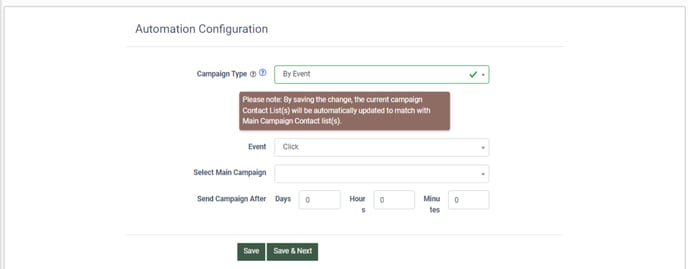
Autoresponder
The “Autoresponder” campaign type allows you to run the campaign based on the time the contact has been in a contact list. Note: If you run the Autoresponder Campaign type, it will take only contacts added to the list in the last two days.
The “Autoresponder” campaign type contains the following settings:
- Schedule Type:
-
- Instantly: The Campaign will run right after the contact is added.
Note: If there are 3rd party processing rules set up for a contact list, the Campaign will be triggered after processing is completed.
-
- With Delay: The Campaign will run right after the selected timeframe.
- Trigger Campaign After: Specify Days, Hours, and Minutes to trigger and run the campaign after the contact was added to the list (Only for the “With Delay” schedule type).
- Resend message(s) to updated contacts: Check the box to send the message again to the same contact based on the field updated trigger.
- Update on contact's field: Select the specific field from the dropdown list to trigger the re-send message.
- Resend message(s) to re-activated contacts: Check the box to send the message again to the same contact if the contact is re-activated (The contact’s status was changed from Inactive to Active).
- Send Only to new subscribers: Check the box to send the message only to new subscribers in the contact lists.
Click the “Save” button to complete. You can also use the “Save and Next” button to complete the settings and be redirected to the next tab.
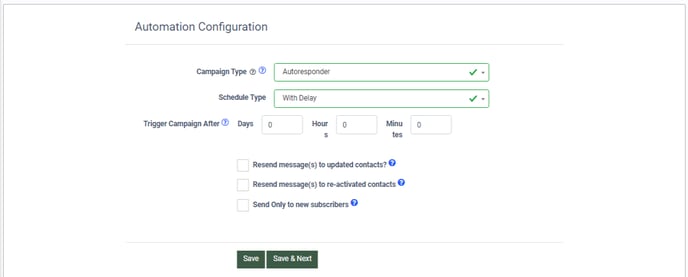
By Count In List (Online)
The “By Count In List (Online)” campaign type allows you to run the campaign based on the number of contacts you have in a contact list.
The “By Count In List (Online)” campaign type contains the following settings:
- Contacts Count: Specify the number of contacts upon reaching which the campaign will be run.
- Resend message(s) to updated contacts: Check the box to send the message again to the same contact based on the field updated trigger.
- Update on contact's field: Select the specific field from the dropdown list to trigger the re-send message.
- Resend message(s) to re-activated contacts: Check the box to send the message again to the same contact if the contact is re-activated (The contact’s status was changed from Inactive to Active).
- Send Only to new subscribers: Check the box to send the message only to new subscribers in the contact lists.
Click the “Save” button to complete. You can also use the “Save and Next” button to complete the settings and be redirected to the next tab.

Template Settings
The “Template Settings” tab allows you to manage and customize the templates for your SMS Campaign.
To configure the “Templates” tab, select the scheme from the “Template Mode” drop-down list. The following modes are available:
-
Simple: Allows you to select and edit one template in the campaign.
-
A/B Testing: Allows you to select and edit several templates in the campaign.
-
Template: Select the template from the existing list.
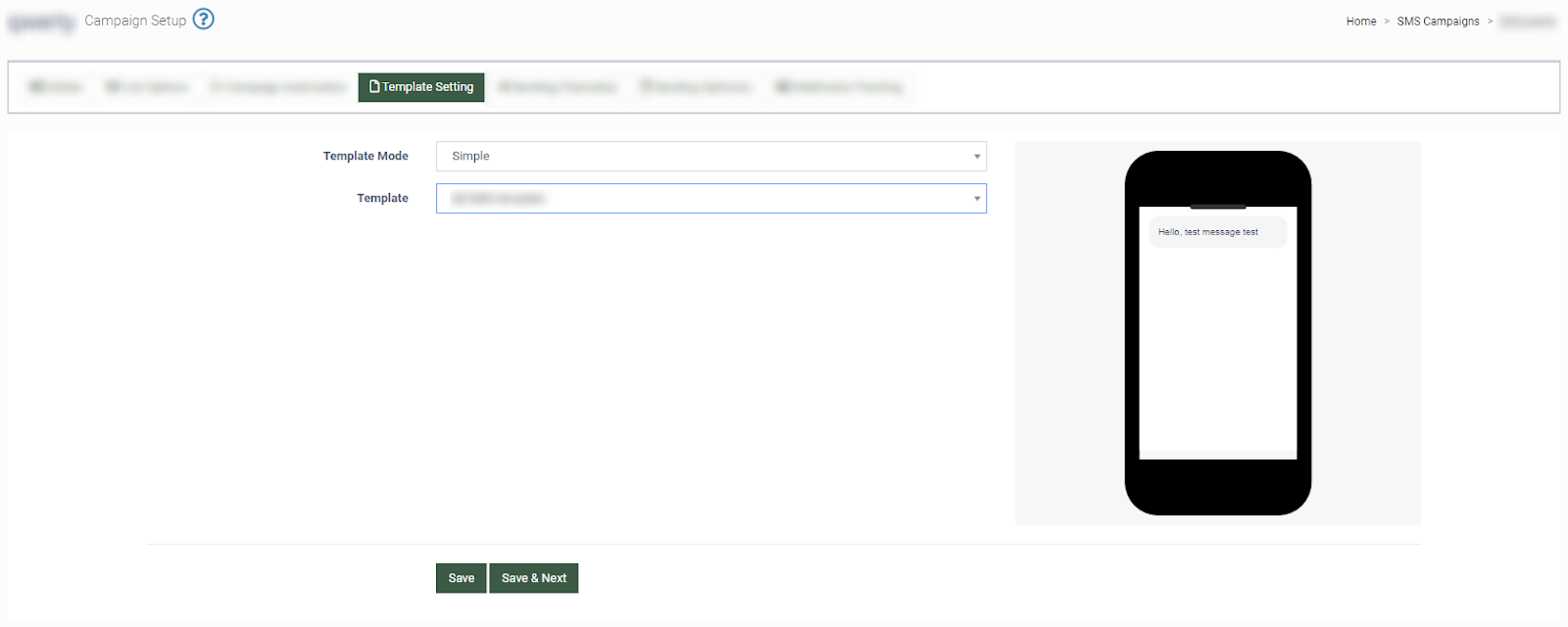
If you select “A/B Testing” Template Mode, fill in the following data fields:
-
Select Count: The number of templates that will be used.
-
Template 1: Select a template from the drop-down list.
-
Template 2: Select a template from the drop-down list.
-
Auto-Send Remaining SMS: Select the “Enable” button to send the SMS Campaign with different templates based on the A/B Test configuration. The template with higher performance will be selected for the campaign.
If you select “Enable” Auto-Send Remaining SMS button fills the following data fields:
-
A/B Test Group Percentage: Select the percentage ratio size of the test group.
-
SMS Percentage to send to each Template: Select the percentage ratio for using the selected template.
-
Select Winning Criteria: Select the Unique Clicks option.
-
Select Winner After: Specify Days, Hours, and Minutes after which will be specified Winning Criteria.
Click the “Save” button to complete. You can also use the “Save and Next” button to complete the settings and be redirected to the next tab.
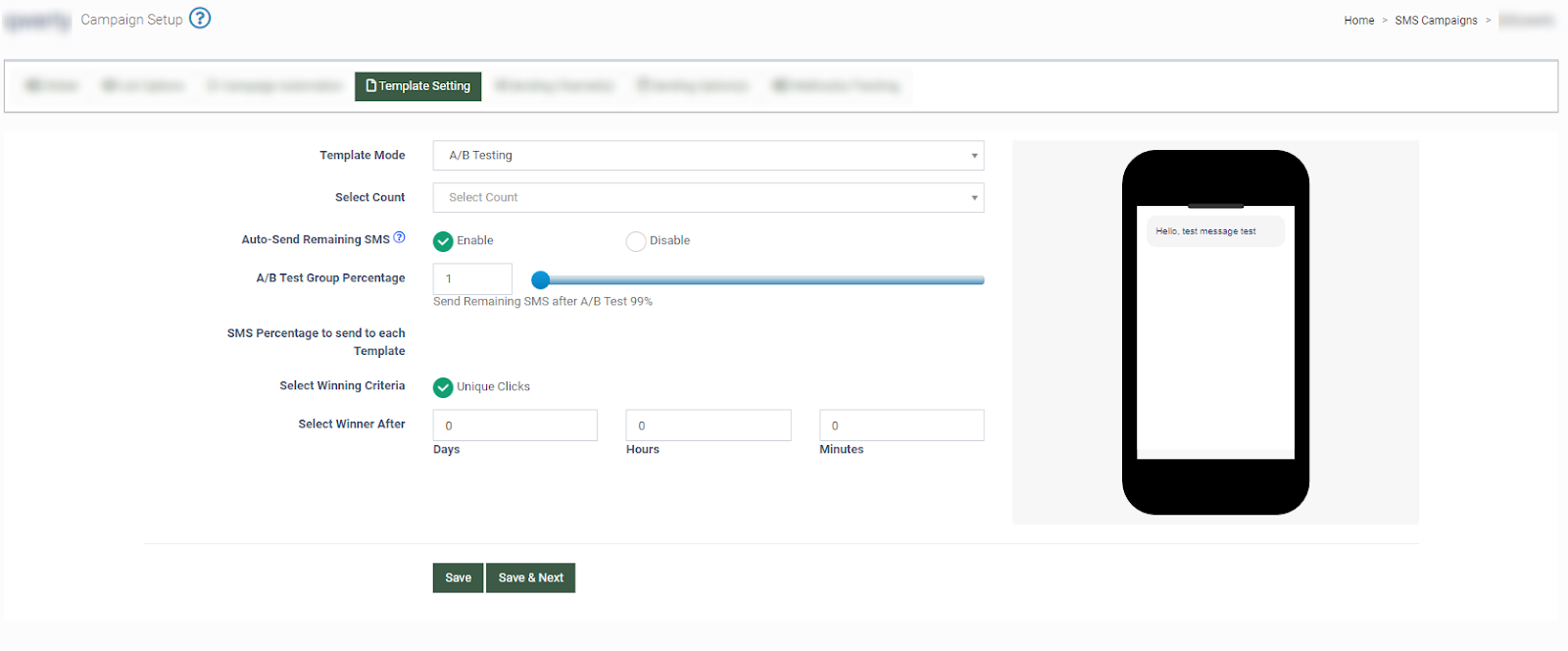
Sending Channel(s)
The “Sending Channel(s)” tab allows you to manage the sender configuration.

The “ESP Routing” block allows you to select the type of delivery channel and contains the following fields:
-
Send type: Select the type of the delivery channel: Single Channel or Multiple Channel.
-
Select Channel: Select the delivery channel from the existing one.

The “Sender Configuration” block allows you to set up the sender settings. Depending on the value (selected in the “Send Type” field), the block will have different settings options.
If the “Single Channel” option is selected in the “Select Channel” field, you can select one channel.

The “Sender Configuration” block allows you to set up the sender settings. It contains the following fields:
-
Sender Group: Select the sender group (allows you to have the option to select one sender ID or all senders (round-robin) logic).
-
Sender ID: Select the sender from the existing one or All Sender (ID)s (Round Robin).

Click the “Save” button to complete.
If the “Multiple Channel” option is selected in the “Send Type” field, you should select at least two channels. The “Sender Configuration'' block contains the following fields:
-
ESP: The name of the channel.
-
Sender Group: Select the sender group from the existing one.
-
Sender ID: Select the sender ID from the existing one.
In the “Split Ratio” block you can set up the ratio for the distribution between channels. The values for the percentage should be filled out in the “Percentage” column.
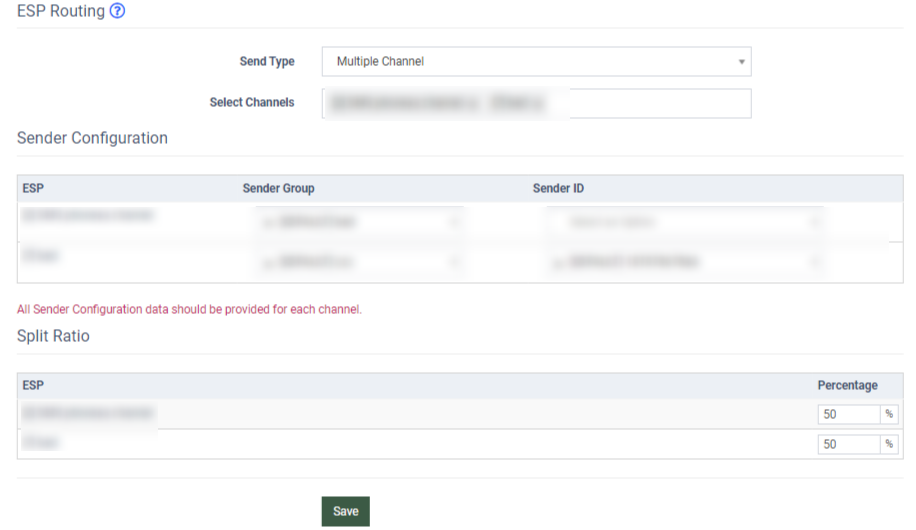
Enter the information and click the “Save” button to complete.
Notifications
The “Notifications” tab allows you to configure the option of sending a notification if the campaign is not sending any messages for a specific timeframe.
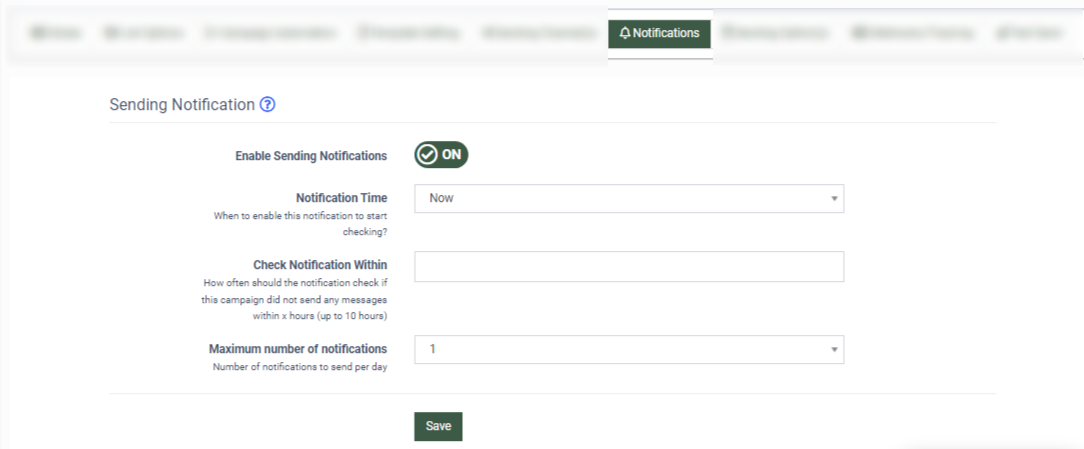
The “Sending Notification” block contains the following fields:
-
Enable Sending Notifications: Switch the toggle to the “On” position to enable the Sending Notifications option.
-
Notification Time: Select the timeframe after which the system will start checking the campaign and send the notifications (Now, After 1 day(s), etc.).
-
Check Notification Within: Select the time frame for how often the system should check if this campaign did not send any messages (From 1 and up to 10 hours).
-
Maximum number of notifications: Select the number of notifications to be sent per day (1 or 2 times per day).
If there are new notifications for the Сampaign, they will be displayed as a red warning icon in the “Actions” column under the “Campaigns” section, and the system will also send a notification message to the email address.
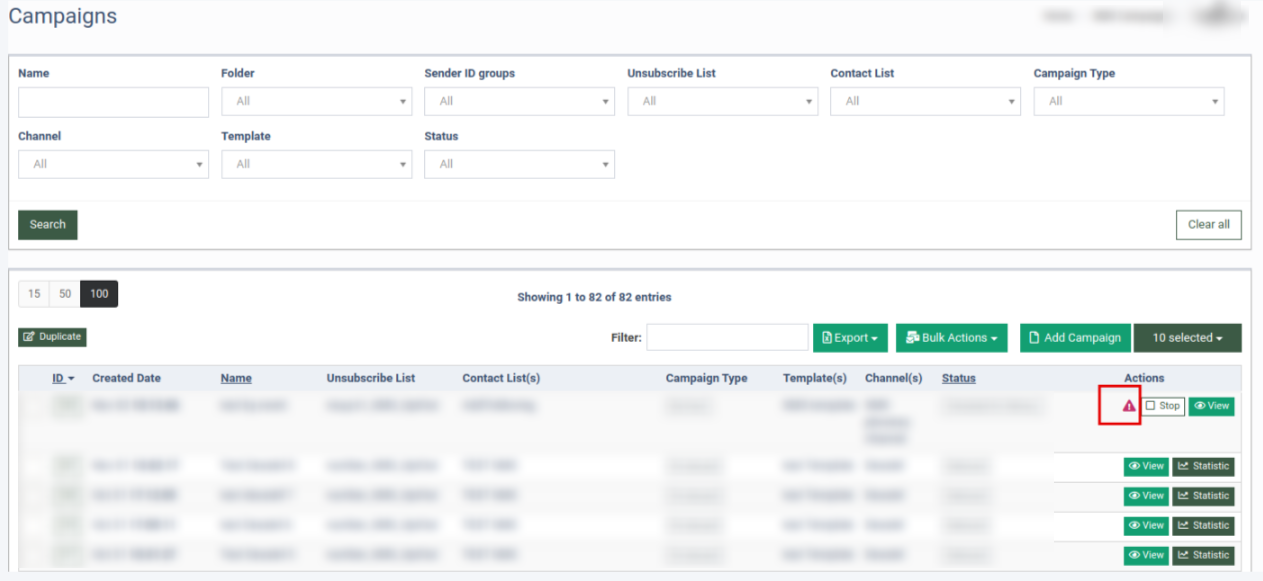

To customize the system notifications go to System Management > General > Project Settings > E-delivery tab.
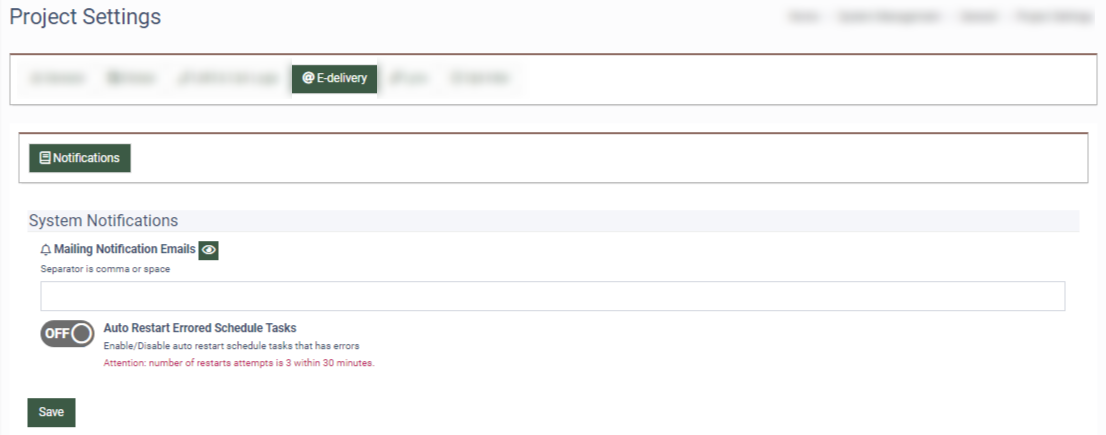
Sending Option(s)
The “Sending Option(s)” tab allows you to choose the automated pause campaign by a certain time and limit send by the number of SMS per hour.

The “Sending Option” block contains the following fields:
-
Pause Campaign: If the “Yes” field option is selected you can pause the campaign activity for a certain amount of time.
-
Use Contact Timezone: If the “Yes” field option is selected the message will be sent to contact by contact timezone which is defined by ZIP code or country or/and region. Otherwise, campaign or system timezone used. If the “No” field option is selected choose “Pause Timezone” in the dropdown list.
-
Pause Schedule: Select the timeframes for the pause by each day and time.
Enable/Disable: Click the checkbox to enable/disable the pause for a certain day.
Pause (24 hrs)?: Click the checkbox to enable/disable the pause for 24 hours.
Day: Monday, Tuesday, etc.
Pause Between (HH::MM): Enter the time for the pause.
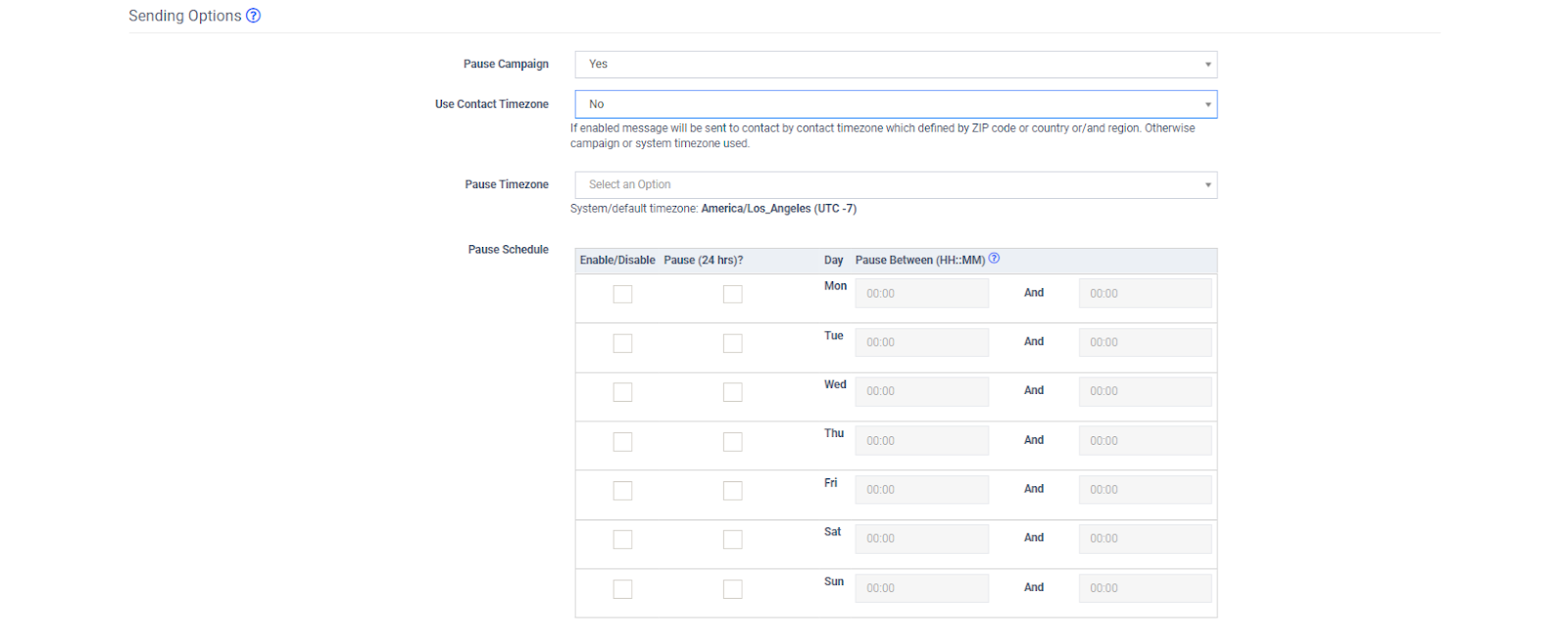
If in the “Limiter Enabled” field the “Yes” option is selected you can set up the limitation for the number of SMS sent per hour. Fill in the SMS quantity limit in the “Per Hour Limit” field and the total number of SMS that can be sent for the selected campaign in the “Total Campaign Limit” field. Click the “Save” button to complete.

Webhooks/Tracking
The “Webhooks/Tracking” tab allows you to set up tracking activity depending on the status of the campaign. The “Webhooks/Tracking” tab contains the following information:
-
Tracking URL: Tracking URL address.
-
Fire Action Event: Event after which webhook/tracking will be enabled (SENT, SENT FAILED, DELIVERED, DELIVERED FAILED, CLICKED, UNSUBSCRIBE).
-
Method: HTTP method of the webhook/tracking (GET, POST).
-
Status: Status of the tracking URL (Active, Disabled, Duplicating).

Click the “+ Add Tracking Link” button to add the tracking link and fill in the following fields in the “Add Tracking Link” pop-up window:
-
Fire on Action: Select the event after which webhook/tracking will be enabled (SENT, SENT FAILED, DELIVERED, DELIVERED FAILED, CLICKED, UNSUBSCRIBE).
-
Method: Select the HTTP method of the webhook/tracking (GET, POST).
-
URL Contact Fields: Enter the tracking URL address. Also, you can add the Contact Fields (Email, Phone, First Name, Last Name, Country, City, Address, State, Zip, Day Of Birth, Custom field).
-
Status: Select the status of the tracking URL (Active, Disabled, Duplicating).
Click the “Add” button to confirm. Click the “Cancel” button to disallow the changes.
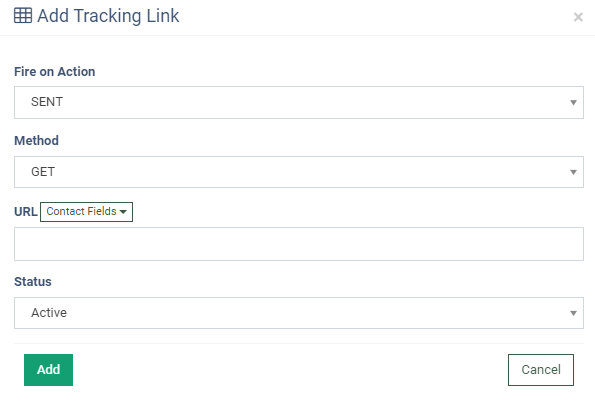
Click the “Edit” button in the “Actions” column to edit the tracking link and fill in the following fields in the “Edit” pop-up window:
-
Fire on Action: Select the event after which webhook/tracking will be enabled (SENT, SENT FAILED, DELIVERED, DELIVERED FAILED, CLICKED, UNSUBSCRIBE).
-
Method: Select the HTTP method of the webhook/tracking (GET, POST).
-
URL Contact Fields: Enter the tracking URL address. Also, you can add the Contact Fields (Email, Phone, First Name, Last Name, Country, City, Address, State, Zip, Day Of Birth, Custom field).
-
Status: Select the status of the tracking URL (Active, Disabled, Duplicating).
Click the “Add” button to confirm. Click the “Cancel” button to skip without saving.
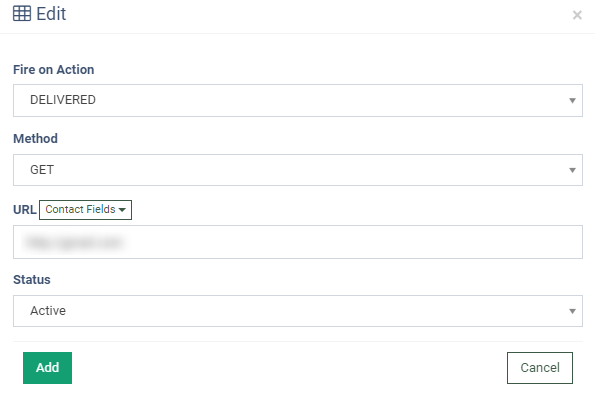
Click the “Delete” button in the “Actions” column to delete the tracking link. In the “Delete” pop-up window click the “Delete” button to confirm. Click the “Close” button to cancel the changes.

Logs
The “Logs” tab allows you to view the SMS campaign status changes and updates.
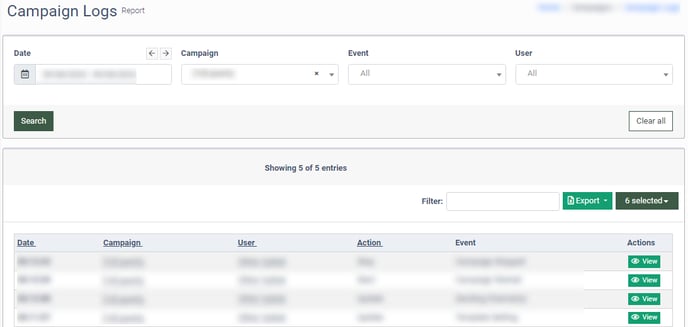
Once you click the “Logs” tab the system will redirect you to the Campaign Logs section.
Note: Read more about the Campaign Logs in this Knowledge Base article.
